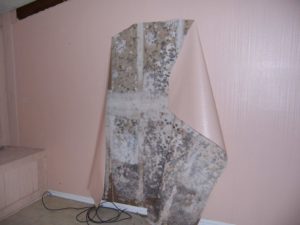How to Identify, Remediate, & Prevent Mold Behind Wallpaper
Mold can grow and thrive behind wallpaper, causing damage to the walls and posing a health risk to your family and your pets without you even realizing that there is an issue.
This article will explain how to identify, remediate and prevent mold from growing under your wallpaper.

Is Mold Behind Wallpaper Dangerous?
There are various types of mold that can grow under wall paper and each of them carry various risks based mainly on the amount of mycotoxins they produce. That being said, any visible mold is cause for alarm because it eats away at your property and can still produce mold spores which cause allergies and damage your lungs if you breath them in excessively. One of the most common types of mold that are found behind wall paper is black mold. This type of mold is also known as stachybotrys, and can be very toxic to your health if left untreated. There are many health dangers associated with black mold behind wallpaper for humans and pets. The effects of mold can range from neurological problems to respiratory problems. If you begin to notice any of the following symptoms, we recommend that you give the number on our website a call right away so we can check if mold is growing in your property.
- Neurological Conditions can include: confusion, shortened attention span, tiredness, and difficulty concentrating
- Respiratory symptoms can include: difficulty breathing, wheezing, coughing, sore throat, runny/clogged nose, and nose bleeds
- Circulatory symptoms can include: irregular heartbeat, low blood pressure, and blood clotting issues
- Vision issues can include: red or bloodshot eyes, eye inflammation, and blurry vision
- Skin symptoms can include: skin irritations, rashes, blisters, and itchiness
- Immune system and reproductive systems can include: infertility, miscarriage, and recurrent infections
Besides the health risks associated with mold, there are also risks to your property. For example, black mold eats away at and deteriorates your walls.
What Causes Mold Under Wallpaper?
Mold is caused by moisture coming into contact with mold spores on a material that it can feed off of like wallpaper. Some amount of mold spores is in the air of every home, so basically all mold needs to grow is moisture. Once mold spores come into contact with moisture and a food source, mold can start to grow within only 24-48 hours.
For this reason, mold under wallpaper is commonly found in bathrooms. The bathroom is often damp which make it the perfect breeding ground for mold. The wallpaper also provides the organic materials and the “curtain of darkness” that help mold thrive.
Another common cause of mold behind wallpaper is the presence of a leaking pipe inside the wall. If you have a pipe that is leaking inside your wall, the moisture and the dark and cool environment make for a perfect environment for mold to grow.
How to Prevent Mold From Growing Anywhere Near Your Wallpaper
Since mold needs moisture to grow, the key to preventing mold from growing in your home is to keep it dry. This means using proper ventilation when showering by opening a window and/or using a fan that vents to the outside of your home.
You can also invest in mold prevention techniques such as water resistant drywall or paint. There are also several products on the market, such as different sprays and coatings that allow you to make your walls more resistant to water damage and mold growth. It is also important to monitor the moisture in your home, you can do this by using a moisture meter. This will help to tell you when your home has gotten to be too humid, making it the perfect breeding ground for mold.
How to Tell if There is Mold Behind Your Wallpaper
Visually detecting mold under your wallpaper is not always an easy task, especially if the wallpaper in your home is thick and dark. Wallpaper hides the existence of mold quite well. One of the most common ways to detect any mold is by smell. Mold, once it begins to colonize and grow will begin to produce an odor. Most people would describe the odor as an earthy odor.
In the case of wallpaper, another good indication of a mold problem will be the presence of any discoloration of the wallpaper or slimy patches in the wallpaper. Again, this can be more difficult to detect if the wallpaper in your home is very dark. There may also be some warping of the wall itself that would tell you that moisture is likely present and in turn, mold is likely to grow also.
If you are unsure if there is mold growing in your property we recommend using a mold testing kit to help you detect it.
How to Remove Mold Under Wallpaper
If you discover mold growing, there are some steps that you can take to prevent it from spreading further. First, you will want to to contain the area using polyurethane sheeting and wear protective gear to prevent the mold spores from spreading or causing health issues. Then you can proceed to remove the wallpaper from the affected rooms in your home. You will want to make sure that you do so in a safe and effective manner. Starting in small sections, you will want spray the wallpaper with a stripping solution and begin peeling the wallpaper away from the walls carefully. Once you have removed all of the wallpaper from the walls you can then begin to address the layer of mold that was hiding behind the wallpaper by carefully removing the affected areas of the wall and disposing of them.
After you have removed and disposed of the affected building materials, you can scrub the walls with a mold spray to get rid of any extra mold growth areas. Be sure to scrub every area of the wall even if you do not see any mold growing as the mold could start to grow back again. Mold spores are small and can be hard to detect until they begin to grow. Once you have cleansed the walls thoroughly, be sure to allow the walls to dry completely with the use of fans and proper ventilation. It is a good idea to buy a HEPA filter to aid in this process.
What if You Have On Wallpaper but Not on the Wall Behind It?
If you have mold on the wallpaper but not on the wall, then there’s a chance that the mold hasn’t spread to to your wall yet. In order to prevent that from happening you should remove the affected wallpaper as soon as possible and dry out any moisture that may have caused the mold in the first place. That being said, don’t be so sure that the mold is only on the wallpaper and not on your walls too. Mold is illusive and it can often hind behind walls where you can’t see it. That’s why it’s best to give our pros a call so that we can properly asses the situation and give you a quote and action plan from there.
Hiring a Professional Mold Remediation Expert
In general, we recommend that you don’t try to remediate the mold yourself because it can be dangerous and the mold could grow back if the remediation process is not done correctly.
A professional mold removal company will know how to remove all of the mold in the safest and most effective manner. Call the number on our website today to receive a free estimate from a mold professional anywhere in the USA!
